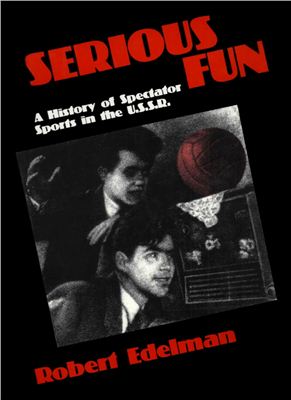New York/Oxford: Oxford University Press, 1993
English book. Edelman (history, Univ. of Califoia at San Diego) offers this well-documented, scholarly coverage of spectator sports in the USSR from 1917 to 1991. The emphasis is on soccer, ice hockey, and basketball, but the reader will have an understanding of other sports the USSR used to gain their huge Olympic medal totals. The author skillfully explains the political milieu and machinations within which sport viewing and sport participation functioned in Soviet life during different eras. The author dispels many misconceptions. Sports did not prove to be effective in furthering political ideology. The elite athletes were not the tip of a vast participant pyramid. The Soviets provided much less of their gross national product for sports than did Weste countries. The Soviet fans, rather than the govement, determined what sports were watched, and women were only minimally involved in participation and spectating. For serious sports collections.
Отталкиваясь от теоретических наработок, существующих в западной культурологии, автор анализирует процесс становления и развития «большой тройки» наиболее зрелищных видов спорта в СССР (футбол–хоккей–баскетбол) и показывает, что, несмотря на тотальное стремление советского государства контролировать всё и вся, спонтанное, игровое начало зрелищного спорта обеспечивало ему определённую автономию и, одновременно, искреннюю «беспартийную» любовь зрителей.
English book. Edelman (history, Univ. of Califoia at San Diego) offers this well-documented, scholarly coverage of spectator sports in the USSR from 1917 to 1991. The emphasis is on soccer, ice hockey, and basketball, but the reader will have an understanding of other sports the USSR used to gain their huge Olympic medal totals. The author skillfully explains the political milieu and machinations within which sport viewing and sport participation functioned in Soviet life during different eras. The author dispels many misconceptions. Sports did not prove to be effective in furthering political ideology. The elite athletes were not the tip of a vast participant pyramid. The Soviets provided much less of their gross national product for sports than did Weste countries. The Soviet fans, rather than the govement, determined what sports were watched, and women were only minimally involved in participation and spectating. For serious sports collections.
Отталкиваясь от теоретических наработок, существующих в западной культурологии, автор анализирует процесс становления и развития «большой тройки» наиболее зрелищных видов спорта в СССР (футбол–хоккей–баскетбол) и показывает, что, несмотря на тотальное стремление советского государства контролировать всё и вся, спонтанное, игровое начало зрелищного спорта обеспечивало ему определённую автономию и, одновременно, искреннюю «беспартийную» любовь зрителей.

